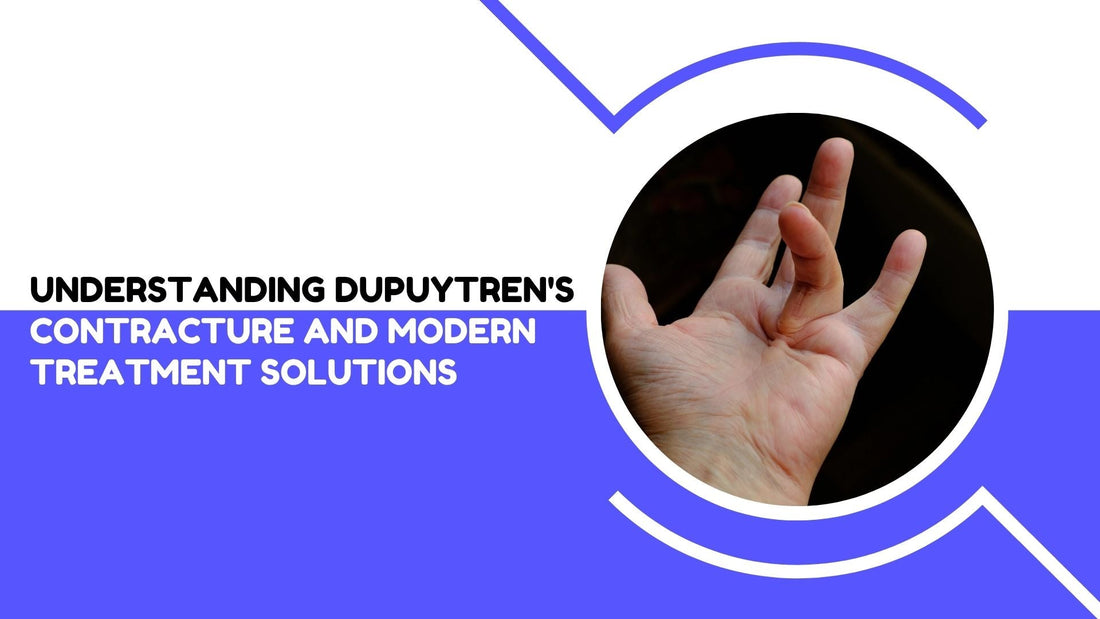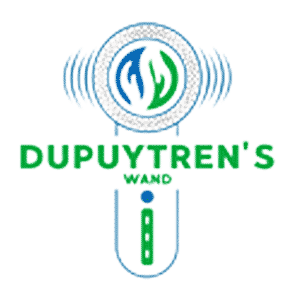
Understanding Dupuytren's Contracture and Modern Treatment Solutions
Share
Millions of people around the globe have a hand condition that has been mysteriously operating over the centuries, which has therefore received quite an interesting nickname, the Viking hand disease. This disease is formally called Dupuytren's contracture, and it has not only aroused interest because of its disabling effects on functioning hands in the particular joint, but it is also of interest because of its interesting genetic affiliations with our distant ancestors. In today's week, we are going to discuss the Viking disease Dupuytren and how it is affecting the lives of people in modern times and how our new and innovative methods, such as Dupuytren's Wand, can be used to manage the treatment of this ancient disease.
What is Viking Hand Disease?
Viking hand disease, also known medically as Dupuytren's contracture, is a slowly advancing condition of the hand which attacks the fascia, a thin tissue of tendons beneath the skin on the palm as well as on the fingers. The condition, also known as Dupuytren, through which the affected person experiences a gradual thickening, tightening and roping up of this tissue, into a rope-like cord which later retracts the fingers into a permanent bent formation, was named after Baron Guillaume Dupuytren, a French surgeon who was the first to describe the condition in 1831.
The disease normally starts with painless, tiny nodules in the palm that most individuals do not take seriously, but instead view them to be harmless lumps. With time, these nodules may swell to become thick and cord-like like extending out of the palm to end in the fingers. These pulling cords, when they get tightened up, naturally pull these affected fingers--which are most often the ring and little fingers--towards the palm, so that it becomes gradually harder and harder to straighten them out.
The Viking Connection: Why is it Called Viking Hand Disease?
The moniker "viking hand disease" stems from compelling epidemiological evidence showing that Dupuytren's contracture occurs most frequently in people of Northern European descent, particularly those with Scandinavian ancestry. The highest incidence of the condition has been recorded in Iceland, and high rates across Scandinavia have caused theorizing about the origins of the condition within the sea-faring Norse populations.
The disease known as Dupuytren's can be referred to as the Viking disease because it is more common in countries around the Mediterranean, too. The distribution in this geography in the early days of research indicated a possibility on possibility that Viking migrations and settlements were likely to have spread the genetic predisposition throughout Northern Europe, including the British Isles and other areas where the influence of the Norse people was historically important.
But new genetic studies have shown an even more intriguing result. A study published recently in Molecular Biology and Evolution demonstrates that a predisposition to a condition called Dupuytren's disease is partially of Neandertal ancestry. Scientists have discovered that some of the major genetic risk factors for Dupuytren's viking disease may trace back to our Neanderthal ancestors, adding another layer of complexity to our understanding of this condition's evolutionary journey.
Beyond the Vikings: Modern Understanding of Dupuytren's Disease
While the viking hand disease nickname persists in popular culture, modern genetic analysis has provided a more nuanced understanding of the condition's origins. Recent research has shown no relationship of an overrepresentation of Norse ancestry with Dupuytrens disease, so that the Viking connection might be, as it were, more of a lucky accident, are coincidence rather than causative.
Thereby, research indicates that Dupuytren disease is exhibited in 0.49 per cent among people of predominantly African descent as compared to 1.37 among people of predominantly European descent. Such data proves that it is not a disease that is related only to Vikings, even though it is more common to be affected by the condition among people of European descent.
Dupuytren will occur in one out of every ten men of European descent at some point during their lives and occurs much more frequently in men than women, usually after age 40.
Risk Factors and Symptoms
Understanding the risk factors for Dupuytren's viking disease can help individuals recognize early signs and seek appropriate treatment. Key risk factors include:
Genetic Factors:
Northern European ancestry (particularly Scandinavian, Scottish, or Irish heritage)
Family history of the condition
Male gender
Age over 40
Lifestyle and Health Factors:
Diabetes
Excessive alcohol consumption
Smoking
Previous hand trauma or repetitive hand strain
Certain medications
Early Warning Signs: The progression of Viking hand disease typically follows a predictable pattern. Initial symptoms include small, tender nodules on the palm, often mistaken for calluses or minor injuries. As the disease progresses, the nodules can lose their tenderness and become more visible, and they ultimately turn into thick, rope-like strands that hamper the freedom of movement in the fingers progressively.
The Impact on Daily Life
Living with Dupuytren's disease can significantly impact quality of life. Simple everyday tasks most people enjoy, like shaking hands, wearing gloves, reaching inside pockets, or playing musical instruments, become even more problematic. The gradual nature of the condition implies that in cases where no treatment is done, the use of hands gradually declines with time.
A significant number of patients complain of the progressive impairment of hand dexterity especially when it constitutes a loss of the dominant hand. Career and work can be impaired, and it can be unexplicable to maintain hobbies, audio-motor skills.
Traditional Treatment Approaches
Historically, treatment options for viking hand disease have been limited and often invasive. Traditional approaches include:
Surgical Intervention: The conventional treatment is usually surgery to remove the affected tissue, also called fasciectomy. Surgery is useful in extreme cases but has a chance of having complications, takes long to heal and can lead to nerve damage or loss of sensitivity.
Needle Aponeurotomy: This is a less invasive procedure in which the contracted cords are separated using a needle, with results being on a temporary basis, and the condition can recur.
Injectable Treatments: Enzyme injections can help break down the contracted tissue, but these treatments are expensive, may require multiple sessions, and are not suitable for all patients.
Revolutionary Home Treatment: The Dupuytren's Wand
The introduction of the Dupuytren's Wand has transformed the treatment landscape for Dupuytren's viking disease. The Dupuytrens wand is an ultrasound and far infrared home unit for Dupuytrens contracture, offers quick and affordable.
This cutting-edge device is a game changer from invasive medical procedures to non-invasive home treatment, which patients can easily fit into their daily schedule.
How the Dupuytren's Wand Works
The Dupuytren's Wand is specifically designed home therapy equipment that allows for the release of the breaks of the thickened tissue located in the palm by increasing the possibility of its tension and normalizing finger movements. It diffuses concentrated warmth and soft energy to the place of application, and this process stimulates the blood flow and facilitates soft tissue relaxation.
The device combines several therapeutic modalities:
Far Infrared Technology: Dupuytren's Wand is a hand held device which, when hyped on the hand, produces far infrared and heat waves which penetrate deep into the tissues of the hand and liquefy the fibrous tissue which produces the contracture. This intense warmth leads to an improvement in the circulation of the blood and tissue flexibility.
Ultrasound Therapy: The ultrasound technology used in it provides soft vibrations which loosen and soften the contracted tissue and reduce inflammation, making the restoration of normal hand activity easy.
Targeted Treatment: Dupuytrens wand is a technology based massage device that is aimed at forcing blood in areas that have cords, nodules and hard lumps to soften. It precisely targets areas that have this problem but it does not affect the health tissue.
Benefits of the Dupuytren's Wand Approach
The Dupuytren Wand has many benefits compared to the conventional treatment procedures:
Non-Invasive Therapy: The Dupuytren's Wand is non-invasive; it does not require incisions, anaesthesia or a recovery period that follows. Patients are still able to perform their additional activities on a regular basis as well as during treatment.
Cost-Effective Device: The non-surgical treatment of Dupuytren Contracture is a cost-effective home remedy that makes it an excellent method to treat Dupuytren Contracture condition and help restore the movement in the hand, and this device can postpone surgical intervention particularly in the initial stages of Dupuytren Disease. This single investment in the device will have the capacity to save thousands of dollars in medical procedures.
Convenience and Privacy: As an advantage, portability is one of the features of Dupuytren's Wand. Patients can also receive treatment in their homes at their schedule, as the wand can be utilised in any place, unlike other treatment procedures.
Gentle and Safe: The machine offers safe gentle surgery, which minimizes the possibility of complications that occur with more intense interventions.
Combining Treatment with Dupuytren's Tape
With the Dupuytren's Wand along with Dupuytren's Tape, you may obtain an uncomplicated stretch which mildly repairs your mobility. After application of Dupuytren's wand, Dupuytren's tape is to be applied later to the involved finger.
Compared to the usual splinting, Dupuytren tape enables the patient to hold objects in the normal manner because it does not block the processes of closing the hand. This new product offers constant mild stretching without interference with hand use in everyday life.
Early Intervention: Key to Success
The most successful outcomes with the Dupuytren's Wand occur when treatment begins in the early stages of Dupuytren's viking disease. The most commonly used device is the Dupuytren's Wand. The stretch is typically controlled by an elastic tape "splint" offering a strong recoiling effect to encourage the finger to remain in a straightened position.
Early intervention can:
Slow or halt disease progression
Maintain hand function longer
Reduce the likelihood of requiring surgical intervention
Improve overall quality of life
Looking Forward: Hope for Dupuytren's Patients
For the millions of people worldwide affected by viking hand disease, the development of innovative treatments like the Dupuytren's Wand represents a significant advancement in care. The Dupuytrens Wand is a successful home remedy to cure dupuytrens contracture and work can be done at home which can help to ease the contraction, tenderness and even can postpone the surgical process which is quite expensive.
The new technology brings hope to people who had little or no options previously and gives a way of supporting hand activity and life quality without dealing with the risks and expenses of the orthodox methods of treatment.
Conclusion
The journey from Dupuytren's viking disease as a mysterious ailment affecting Northern European populations to our present knowledge of its complicated genetic origins is astounding achievements of the medics. The issue being more complicated as we now know than initially we would have assumed the condition has continued to have a major effect on the lives of millions of people in the world.
The establishment of the Dupuytren`s Wand is the first revolution in treatment availability and its correspondence. With the help of a far-infrared technology, an ultrasound therapy, and specific treatment protocols, this device provides patients with a chance to control their condition from the comfort of their home.
For those living with viking hand disease, the future looks brighter than ever. With early intervention using innovative tools like the Dupuytren's Wand, many patients can maintain hand function, avoid surgery, and continue enjoying the activities they love. The ancient curse of the Vikings may finally be meeting its match in modern therapeutic innovation.
If you're experiencing early signs of Dupuytren's contracture, don't wait for the condition to progress. Explore how the Dupuytren's Wand can help you maintain your hand health and quality of life. Visit our website to learn more about this breakthrough treatment option and take the first step toward reclaiming your hand function.
